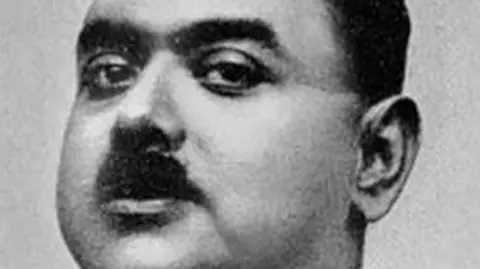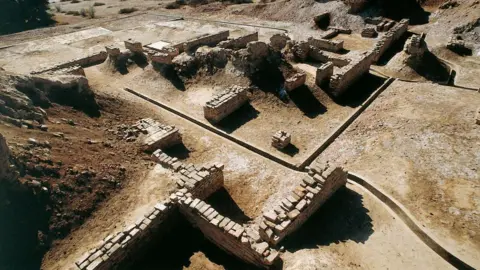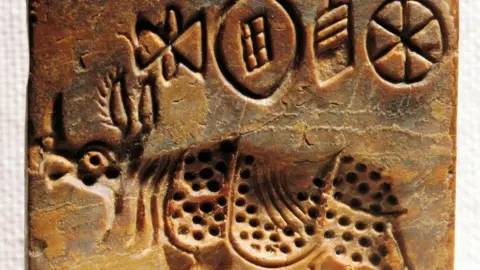Forgotten Indian explorer discovers an ancient civilization

BBC News, Mumbai
 Alami
AlamiThe career of Indian archaeologists is marked by glory and controversy, and is one of the greatest historical discoveries in the world. However, today he is still largely forgotten.
In the early 1900s, Rakhaldas Banerjee (also spelled Banerji) unearthed Mohenjo -daro – in today’s Pakistan, meaning “the mound of the dead” in the Sindhi language. It is the largest city of the booming Harappan civilization, which ran from northeast Afghanistan to northwestern India during the Bronze Age.
When the country was colonized by British rule, a brave explorer and talented resident Banerjee worked for the Archaeological Survey of India (ASI). He spent months traveling to far corners of the subcontinent, searching for ancient artifacts, ruins and scripts.
But while his discovery of Mohenjo-Daro was groundbreaking, Banerjee’s legacy was cast in shadow by the dispute. His independence stripes and contempt for colonial agreements often put him in trouble – gaining reputation and even removing part of his contribution from global memory.
 Getty Images
Getty ImagesInterestingly, ASI has never published a report by Banerjee about Mohenjo-Daro. Archaeologist PK Mishra then accused John Marshall of then-head of ASI for curbing Banerjee’s discovery and demanding his praise for the discovery.
“The world knows that Marshall discovered the ruins of civilization, and it was taught in the institution. Banerjee is a trivial footnote,” Professor Mishra Tell Times of India newspaper.
In her book Finding Forgotten Cities: How to Discover Indian CivilizationHistorian Nayanjot Lahiri wrote that Banerjee “lack of diplomacy and wit and showed a master of feathers.” Her book also sheds light on the controversy he was involved in during ASI.
She noted that he had tried to obtain inscriptions and images from museums in Northeast India without the approval or knowledge of his boss.
Another time, Banerjee tried to relocate some stone sculptures from a museum in Bangladesh to his stationed without the necessary permit.
In another case, he purchased an antique painting without consulting his boss, who believed his salary exceeded the necessary expenses.
“Many of Banerjee’s talents seem to include always being able to rub people in the wrong way,” Rahiri wrote.
 Getty Images
Getty ImagesHowever, because of its connection to Mohenjo-Daro, Banerjee remains an outstanding figure among world historians and scholars in Bangladesh.
He was born in 1885 in a wealthy family in Bangladesh.
The city he grew up with medieval monuments scattered with interest in history ignited his interest and pursued the topic in college. But he always has risky winning streaks.
Once, when he was appointed to write an article about the Scythian period in Indian history, he traveled to a museum in a neighboring country to study first-hand sculptures and scripts of that era.
In her book Rakhaldas Banerji’s life and worksauthor Yama Pande noted how Banerjee joined ASI as an excavation assistant in 1910, and in 1917 a supervisor in western India quickly became a rank.
It is in this article that he first looked at Mohenjo-Daro in Sindh in 1919. Over the next few years, he conducted a series of excavations at the site, revealing some of the most fascinating discoveries: ancient Buddhist Buddhism, coins, seals, pots, pots, pots and microstones.
Between 1922 and 1923, he discovered several layers of ruins with clues about various urban settlements in the region, but most importantly, the oldest urban settlement that existed about 5,300 years ago – the Indus Valley Civilization.
At that time, historians had not discovered the full scale of Indian civilization, and we now know that the vastness of about 386,000 square miles (999,735 square kilometers) along the Indus Valley.
The three seals discovered by Banerjee have images and scripts similar to those of Harappa, Punjab, Pakistan today. This helps to establish a connection between the two locations, thus illuminating the wide range of Indus Valley civilization.
 Getty Images
Getty ImagesBut by 1924, Banerjee was drained for the project and he was also transferred to eastern India. Pande wrote in her book that he had no contact with the site and had not participated in any excavations.
But Nayanjot Lahiri pointed out that Banerjee was transferred at his request after he was entangled in his spending issues. He didn’t consider several job-related expenses.
It also revealed that Banerjee used excavation grants to buy office furniture and his travel expenses were too expensive.
His explanation failed to convince his boss and suggested disciplinary action. After some negotiations, Banerjee obtained his request and moved to another area.
Banerjee continues to work with ASI in eastern India. He spent most of his time in Kolkata (now Kolkata) and oversees the restoration of many important monuments.
He resigned from ASI in 1927, but his departure was damaged by controversy. In the years before his departure, he became the main suspect in idol theft.
It all started in October 1925, when Banerjee visited a respected Hindu shrine in Madhya Pradesh, which houses the stone idols of Buddhist goddesses. Lahiri noted in the book that Banerjee accompanied two low-level assistants and two workers.
However, after their visit, the idol disappeared and Banerjee was suspected of theft. He denied being involved in the disappearance and investigated it.
Idols were later recycled in Kolkata. Although the case against Banerjee was dismissed and the charges were found unconfirmed, Marshall insisted on resigning.
After leaving ASI, Banerjee served as a professor but faced financial difficulties due to his luxurious lifestyle.
Historian Tapati Guha-Thakurta Tell Banerjee squandered telegraph newspapers with delicacies, carriages and friends. In 1928, he joined the Banaras Indian University (BHU) as a professor. Two years later, he died at the age of 45.
Follow BBC News India Instagram,,,,, Youtube,,,,, twitter and Facebook.




